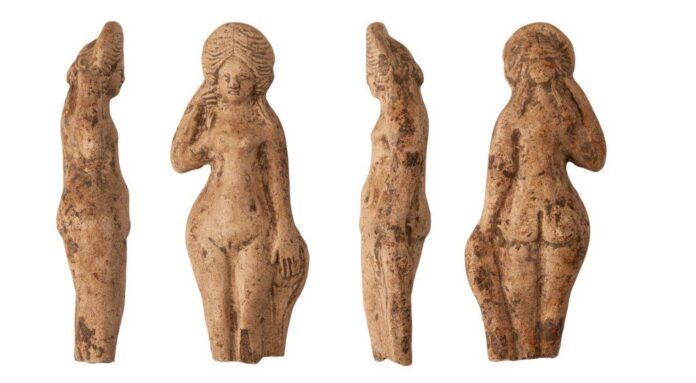Out of the trash and into the museum. That’s the likely outcome for a Roman-era Venus statuette excavated in February from a former trash heap in Brittany, northwestern France.
The well-preserved four-inch tall terracotta figurine shows the Roman goddess of beauty holding a garment in her left hand and a braid of hair in her right. The depiction is known as Venus Anadyomene, Greek for “Venus rising from the sea,” a form portrayed in well-known paintings by Sandro Botticelli and Titian.

A fragment of a Venus statuette. Photo: Emmanuelle Collado, INRAP.
The statuette is composed of Burgundy clay and dates from the end of the 1st century or the beginning of the 2nd century, as suggested by the styling of Venus’s hair. There was a fragment of another Venus found onsite and experts speculate they might have been intentionally placed at the base of the site to bring good fortune.
“We regularly find this kind of statuette during excavations, but they are rarely as well-preserved and as special as this one,” the site’s manager Nicolas Ménez, told French newspaper “We haven’t cleaned it yet and we want to preserve any traces of pigments. We’re still at the beginning of the story about this Venus.”

Small objects found onsite including coins, a metal clasp and a glass fragment. Photo: Emmanuelle Collado, Inrap
The Venus statuette was part of a larger cache of artifacts dating back 1,800 years that was uncovered in a former Roman shale quarry on the site of modern-day Rennes. The city was founded as Condate in the 1st century and had been the main settlement of the Gallic Riedones tribe.
The excavation, which occupies an area of roughly 10,000-square-feet, is led by a team from the National Institute for Archeological Research. It has also uncovered pottery fragments, plates, coins, clothes pins, shards of glass, crockery, and other terracotta statuettes on a site that reaches 6.5 feet in depth.

A vase fragment from the site in modern-day Rennes. Photo: Emmanuelle Collado, INRAP
The Romans required vast quantities of stone to build houses, public buildings, and walls which led to the development of quarries across the territories they exerted influence over. The majority of the rock quarried from the site was schist, which was used in local foundations as a mortar. When usable stone at the Condate quarry had been used up at the end of the 2nd century, it became a trash dump.
Archeologists believe the quarry and later trash dump was even larger than the current site and runs beneath what is today a nearby primary school.
More Trending Stories:
A Museum Has Located a Missing Figure That Was Cut Out of This 17th-Century Family Portrait
Ai Weiwei Has Recreated Claude Monet’s Iconic ‘Water Lilies’ Using 650,000 Multi-Colored Lego Bricks
London Will Honor the Victims of the Transatlantic Slave Trade With a New Memorial in the Docklands

























